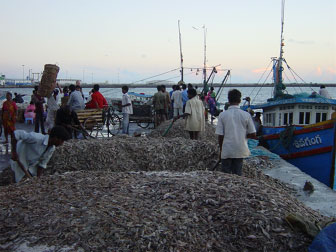One-third of global marine catch used as livestock feed
Jeremy Hance, mongabay.com
October 30, 2008
Despite continuous warnings of emptying oceans due to overfishing, a new report finds that one-third of the world’s total marine catch is not feeding humans, but livestock. The fish are ground-up into meal and fed to pigs, poultry, and even farm-raised fish.
Appearing in the November issue of the Annual Review of Environment and Resources, the study identifies that a major food for livestock is “forage fish”. Examples include anchovies, sardine, and menhaden. In the wild such fish are the primary food source for marine mammals, seabirds (especially gulls and puffins), and several larger fishes.
"We must find a better way to manage forage fisheries before we cause irreversible damage to the broader ocean environment which depends on them as a food source," Joshua Reichert said. Reichert is managing director of the Pew Environment Group, which partnered with The Sea Around Us Project for the study. "Human beings are not the only, or necessarily, the most important consumer of these fish. Whatever people take out of the sea needs to be carefully calibrated to ensure that sufficient fish are left to sustain populations of other fish, seabirds and marine mammals which all play a major role in the healthy functioning of the world's oceans."

Mounds of harvested fish awaiting transport to a processing facility in Kakinada district, Andrea Pradesh, India. Photo by Kieran Kelleher/Marine Photobank |
Dr. Ellen K. Pikitch, executive director of the Institute for Ocean Conservation Science adds that "skyrocketing pressure on small wild fishes may be putting entire marine food webs at great risk."
Even as they are being harvested in numbers that exceed 30 million tons a year, scientists admit they know little about the role forage fish play in the marine ecosystem. What is easier to see is how overfishing forage fish affects local people. These highly nutritious fish were once common in the diets of locals. The removal of these fish for livestock in such numbers directly conflicts with local human consumption in addition to populations of seabirds and marine mammals.
"We need to stop using so many small ocean fish to feed farmed fish and other animals," lead author Dr. Jacqueline Alder added. "These small, tasty fish could instead feed people. Society should demand that we stop wasting these fish on farmed fish, pigs, and poultry." Many of these domesticate animals are still fed on soy and other crops, however forage fish has become an increasingly inexpensive choice, due to the fact that they remain easy to catch in large numbers.
Every year forage fish account for 37 percent of all fish taken from the oceans. A staggering 90 percent of forage fish are processed into fish meal and fish oil. In 2002, nearly half of the fish meal and oil was used to feed farmed fish, while pigs and poultry received nearly a quarter each. Domestic pigs and poultry are such gluttons for seafood that together they consume approximately 14 million tons annually: six times the amount of fish eaten in the United States and double the amount in Japan.
Despite millions of tons of forage fish caught annually there is little management in the industry. The Institute for Ocean Conservation Science at Stony Brook University hopes to change that. A team of scientists and policy makers are launching Lenfest Forage Fish Task Force. The task force plans to develop sustainable management plans for forage fisheries by 2010.
Jacqueline Alder, Brooke Campbell, Vasiliki Karpouzi, Kristin Kaschner, and Daniel Pauly. Forage Fish: From Ecosystems to Markets. Annual Review of Environment and Resources, Vol. 33: 153-166.
RELATED ARTICLES
Armageddon for amphibians? Frog-killing disease jumps Panama Canal October 12, 2008
Chytridiomycosis — a fungal disease that is wiping out amphibians around the world — has jumped across the Panama Canal, report scientists writing in the journal EcoHealth. The news is a worrying development for Panama’s rich biodiversity of amphibians east of the canal.













